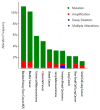HER3 Alterations in Cancer and Potential Clinical Implications
- PMID: 36551663
- PMCID: PMC9776947
- DOI: 10.3390/cancers14246174
HER3 Alterations in Cancer and Potential Clinical Implications
Abstract
In recent years, the third member of the HER family, kinase impaired HER3, has become a target of interest in cancer as there is accumulating evidence that HER3 plays a role in tumor growth and progression. This review focuses on HER3 activation in bladder, breast, colorectal, and lung cancer disease progression. HER3 mutations occur at a rate up to ~10% of tumors dependent on the tumor type. With patient tumors routinely sequenced for gene alterations in recent years, we have focused on HER3 mutations in bladder, breast, colon, and lung cancers particularly in response to targeted therapies and the potential to become a resistance mechanism. There are currently several HER3 targeting drugs in the pipeline, possibly improving outcomes for cancer patients with tumors containing HER3 activation and/or alterations.
Keywords: HER3; alteration; bladder cancer; breast cancer; colorectal cancer; lung cancer.
Conflict of interest statement
The authors declare no conflict of interest.
Figures







References
Publication types
Grants and funding
LinkOut - more resources
Full Text Sources
Research Materials

